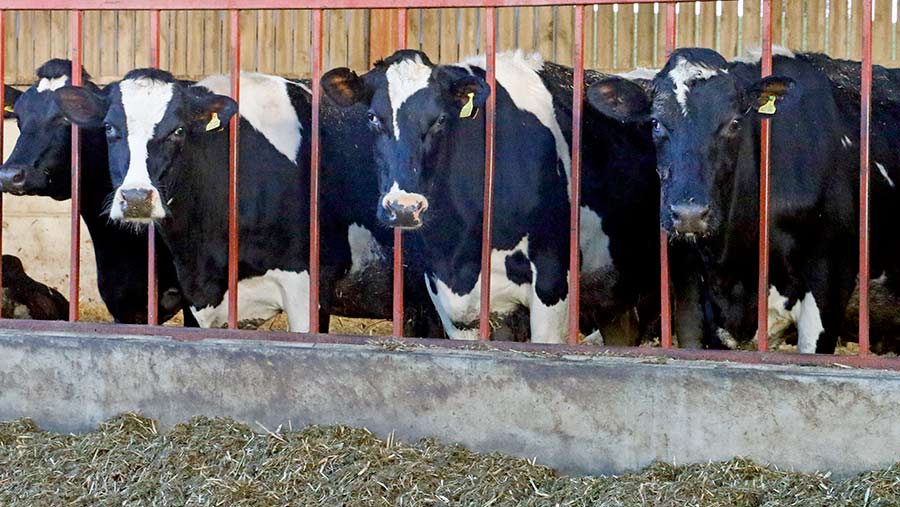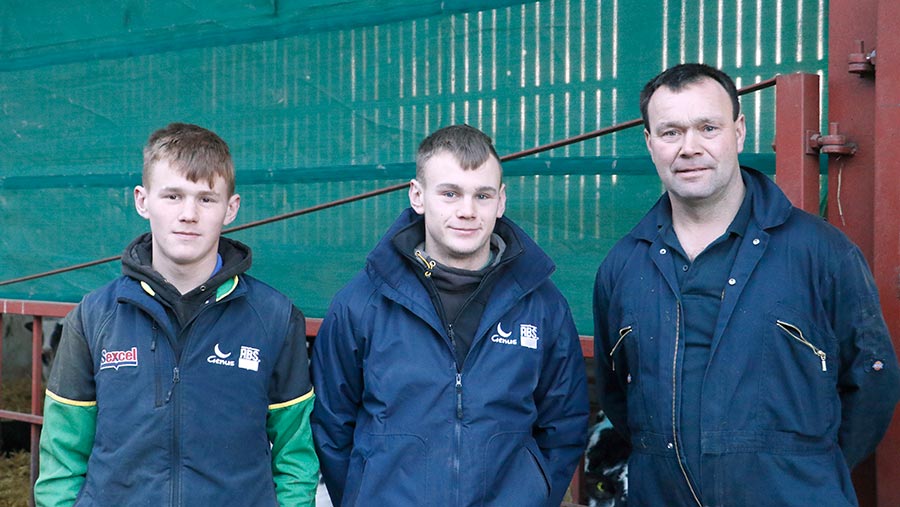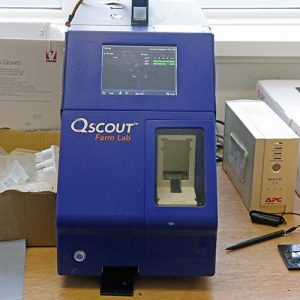How mastitis detection tech helped reduce antibiotics use

Wrexham dairy farmer Stephen Massey says using technology to sample individual quarters for cell counts has given him the confidence to start using teat sealant alone on some of his cows at drying-off.
Mr Massey is one of three Welsh farmers trialling the VetScan DC-Q Scout as part of a Farming Connect-funded two-year study, which started in November 2019.
Previously, he was using antibiotic tubes only on every animal at drying-off, however, a few mastitis cases were common in fresh cows.
This is not unusual, with some farmers using antibiotics-only because they believe they are long-lasting – in fact, they only last in the udder for a short period.
See also: How on-farm mastitis test helped farmer cut antibiotics use
Farm facts
Pentre Isaf Farm, Ruabon, Wrexham

- Milking 330 Holstein cows
- Yielding 8,500 litres at 4.28% butterfat and 3.35% protein
- Calving year-round
- Suppling Tesco Sustainable Dairy Group (TSDG)
- 240 beef cattle sold annually; some sold finished and others as strong stores at 25 months and 60 home-bred replacement heifers reared annually
- Lifetime tenant on the Wynnstay Estate
- Farming 295ha partially owned and rented, including home farm and a separate dry stock and beef unit and rented summer grazing
- Farming in partnership with his wife, Sarah, parents, and alongside their three sons Harry, 19, James, 16 and Ben, 14
Working with vet, Claire Whittle of LLM Farm Vets, steps were taken to reduce infection.
These included using more limed woodchip on top of mattresses to keep udders cleaner and alternating between two dry-cow sheds – one at the home farm and one at their dry stock unit – which has allowed them to rest sheds for one month after cleaning.
This helped reduced fresh cases of mastitis, but Mr Massey knew he needed to start carrying out selective dry-cow therapy (SDCT) to meet his Tesco Sustainable Dairy Group (TSDG) contract requirements.
Still nervous about using teat sealant only, Mr Massey joined the Farming Connect trial to get the most up-to-date cell count data and reassure himself that he was using it on the correct cows.
How the test works
To identify which animals are suitable candidates for SDCT, milk samples are taken from each quarter the day before drying off.
The sample is then picked up by vet tech development co-ordinator Natalie Parker. from LLM Vets, who is overseeing the trial.
Samples are taken to LLM’s Wrexham lab for analysis, with Zoetis’ VetScan DC Q Scout using fluorescent microscopic technology.
The test – known as Milk Leukocyte Differential – counts and differentiates the immune cells lymphocytes, neutrophils and macrophages. These are mobilised when pathogens are present so provide an indication of infection.
The test takes just five minutes and the machine generates a total leukocyte count – positive or negative – as well as the percentage of each of cell types present in each quarter of the udder.
This farmer can then use the information in combination milk records to treat each quarter appropriately at drying off.
Currently, all animals are being tested before to drying off as part of the trial.
Any cow with a cell count over 100,000cells/ml on her last milk recording, or if her highest cell count during lactation exceeds this limit, will automatically be given antibiotics.
The benefits on farm
The precision technology is having real advantages in identifying lower cell count cows with subclinical mastitis that would have otherwise been missed using milk records alone.
“The three cows we have dried off today have come back positive, even though we thought two would be fine according to their cell count.
“If we hadn’t treated them with antibiotics, they could have calved down with mastitis,” explains Mrs Parker.
The dry-cow period is a good time to clear existing mastitis infections because a higher antibiotic dose can be administered outside of lactation.
Since the trial began, Mr Massey has dried off 29 cows and has used teat sealant only on 11 animals; saving antibiotic doses.
Test costs
To save money, Mrs Parker suggests using the test strategically by automatically giving high cell count cows antibiotics.
Then test as a “fail safe” on “outliers” – cows with cell counts rising towards the end of lactation or those exhibiting one high count during lactation.
“It is especially good for farmers who are nervous about moving towards SDCT.
“Antibiotics are there for a reason and they work well if used correctly,” adds Mrs Parker.
Mr Massey says that’s exactly what the test has achieved at Pentre Isaf, adding: “It has given us the confidence to start using teat sealant alone on some of our cows.”
Test pros and cons
- Improves accuracy at drying-off – disadvantages of being solely reliant on cell counts is that averages can disguise subclinical infection in a quarter and data can be invalid by the time it comes to drying-off, especially where milk is not recorded monthly
- More accurate than the Californian Milk Test (CMT)
- Currently can’t be used to diagnose type of pathogen causing infection
- Must know what pathogens are causing mastitis: if you have Staphylococcus aureus mastitis, you shouldn’t use SDCT and the VetScan DC Q Scout wouldn’t be recommended. It is highly contagious and antibiotics may be needed
- Easy to take samples: cleanliness isn’t vital, however, the cow should be stripped out first before the sample is taken
- Easy to store: samples need to be kept out of direct sunlight and kept cool, but don’t need to be refrigerated
Next steps for testing
As part of the trial, Tom Bletcher is using the test to further reduce antibiotics by treating cows on an individual quarter basis.
Mr Bletcher, who has applied SDCT for the past three years in his 350-cow herd, near Mold, in conjunction with Willow Vets Group, is already using teat sealant only on half of his herd.
Antibiotics and a teat sealant are administered at drying-off to the positive quarter. The remaining three-quarters are given sealant only.
There is a risk the infection could spread to the other quarters through the blood, concedes Mrs Parker, however, risks are lower in dry cows.
As cows calve, the test will be conducted again so they can monitor infection spread. It is hoped preliminary results will be ready in six months.
More information

VetScan DC-Q test
This test is not yet commercially available widely and costs to farmers is still being negotiated.
Zoetis is working with vet practices to offer the service.
For more information, visit the VetPartners stand 167 at Dairy-Tech next month.
What is the VetTech service?
The VetTech service at LLM offers hands-on farm support with vaccinations, youngstock health, mobility scoring, worm egg counts, transition checks, body condition and teat scoring.
VetTechs can also carry out training with farmers and farm staff in co-ordination with their vet to maximise the effectiveness of on-farm protocols.
The service has worked well, which is why the VetPartners Group is looking to introduce VetTechs to an increasing number of their farm practices.
